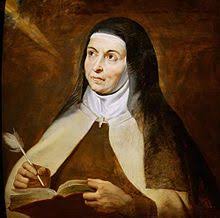HOMILY WEEK 28 05 – YEAR I
Repent, Return, Rejoice:
Memorial of St. Teresa of Jesus
(Rm 4:1-8; Ps 32; Lk 12:1-7)
**********************************************
A dishonest painter took a contract to paint a church, but cheated by thinning the paint. As long as it didn’t rain, he thought he would be okay. That night there was a big storm. He ran to the Church in the morning and saw that the paint was running down the walls. Coming closer, he saw it was forming letters. As he got even closer he could make out the words and read, “Repaint, you thinner, and thin no more.”
The readings today provide us with a message related to that story: Repent, Return and Rejoice.
There are two opposite spiritual stances in the readings: Repentance and Resistance.
The reading and psalm are all about repentance. Paul in his letter to the Romans calls blessed those whose iniquities are forgiven, whose sins are covered, whose sins will not be reckoned against them. The psalm expresses that stance well: Turn to the Lord in times of trouble and be filled with the joy of salvation. It continues to say, happy those whose sins are forgiven, against whom no iniquity is imputed; who confess their sins and receive forgiveness. So, compunction and confession lead to joy. This stance calls us to repent, return to God and rejoice in the experience of salvation.
What we find in the gospel is the opposite – Resistance. Jesus warns us about the yeast of the Pharisees that he names hypocrisy. I would add their unbelief, false pride, and stubborn self-will, all hidden under the cloak of religiosity. They display a total lack of self-awareness, of how sinful they are as they sit in judgement of others and especially of Jesus.
In this passage, Jesus singles out the Pharisees, perhaps because they most represent what is lacking in the religious system of the Israelites of his time. There is a backdrop to this tension. The Jewish religious system had become so corrupt during the time of the prophets that the shekinah, or glory of God that had filled the first temple when it was dedicated, lifted up, left the temple, and headed East. What bothered the religious leaders was that this shekinah or glory of God did not return to the rebuilt temple after the return of the exiles. It was the Pharisees who thought that if they would keep the law perfectly, then the glory of God would return to the temple. That is why the Pharisees became the dominant religious force of Judaism within that self-proclaimed goal. Unfortunately, that stance lent itself to legalism and the heresy of Pelagianism – the mindset that they could become holy through human effort, and therefore did not need a savior, or even a messiah.
What is most interesting is that the shekinah, or glory of God did return, but not to the physical temple of the Pharisees that would be destroyed by the Romans. It returned as flame and wind upon the disciples gathered in the upper room at Pentecost that signified the birth of the Church, the new people of God, the new Temple of God’s presence here on earth.
We are part of that new people of God, that new temple of the Holy Spirit, called to live that out through repentance, returning to God by receiving God’s forgiveness that leads to true joy.
I find that doing a monthly retreat or poustinia allows me time to reflect back on the month, become aware of any sin or sinfulness on my part, and celebrate the sacrament of reconciliation before, during or after that day of retreat. This is my way of repenting, returning to God, and I find that it is always a source of joy.

St Teresa of Jesus
Today the Church honors St. Teresa of Jesus who had to deal with perhaps the opposite religious problem in her day, religious laxity. Teresa was born in Avila, Spain, on Mar 28, 1515. Of the many women who exercised leadership roles in the Church, Teresa must surely be considered among the greatest. When she entered the Carmelite convent, some thought Teresa was a spoiled young woman with an unremarkable prayer life, but she soon advanced in prayer and the spiritual life, experiencing visions and hearing voices. Dissatisfied with the laxity she perceived among the religious, she determined to institute reforms and established St Joseph’s Convent where enclosure and a strict rule prevailed. With the assistance of Peter of Alcantara and John of the Cross, she became a reformer and succeeded in founding the reformed (Discalced) Carmelite order of nuns and friars.
There was much resistance and pushback from even her own order. After the chapter in 1575 and for the next five years, every effort was made to destroy Teresa’s reforms and many of her followers (including John of the Cross) were imprisoned and cruelly treated. At length, in 1580 and with the support of King Philip II, the Discalced Carmelites were made independent and St. Teresa was able to found more new convents.
Teresa wrote several works considered classics of spiritual literature, including The Way of Perfection and The Interior Castle. A great mystic and strong, intelligent and active leader, Theresa was canonized in 1622 and in 1970 became the first woman to be declared a Doctor of the Church. She is patron of Spain. She died, worn out by her efforts, on October 15, 1582.
The Eucharist is a living out of the message of these readings. It is an act of repentance with the penitential rite; the liturgy of the Word calls us to return to the Lord, and it is our greatest prayer that we celebrate with joy.
May our celebration today empower us to repent, return to God with all our hearts, be filled with the joy of the Holy Spirit, and give our lives away selflessly as did St. Teresa of Jesus.



